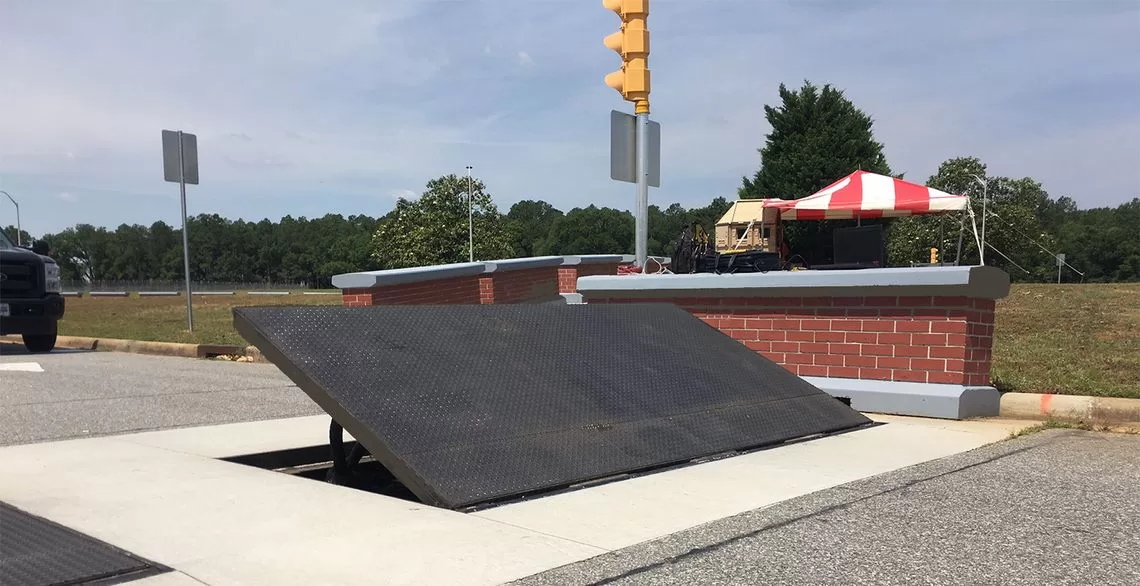Little Known Facts About Wedge Barriers.
Things about Wedge Barriers
Table of ContentsWhat Does Wedge Barriers Mean?The Wedge Barriers Diaries


18 might be done faster, easily, and price efficiently. FIG. In certain embodiments, the support 30 might be a steel frame consisting of plates, beams(e. g., I-beams ), and/or other frameworks that are secured within the foundation 14, which might be concrete. At the surface area 12, an upper side 28 of the anchor 30 might go to least partially subjected
, thus making it possible for the accessory of the obstacle 10 to the support 30. g., threaded openings)in one or more light beams or plates of the support 30 may be revealed to the surface 12. In this fashion, bolts 32 or various other mechanical bolts may be utilized to protect the obstacle 10 to the anchor 30. As the barrier 10 is installed to the surface area 12 of the structure 14, collection of particles and various other material below the barrier might be lowered, and components of the bather 10 may not be subjected to below quality atmospheres. As shown by reference numeral 52, the lifting mechanism 50 includes components disposed below the wedge plate 16. The elements 52 underneath the wedge plate 16 may include an electromechanical actuator, a webcam, one or more cam surfaces, and so forth. Additionally, the training system 50 includes a spring assembly 54
The spring rod read more 58 is coupled to a web cam(e. g., web cam 80 displayed in FIG. 4) of the lifting mechanism 50. The springtimes 60 disposed about the spring pole 58 are held in compression by springtime supports 62, consisting of a fixed spring assistance 64. That is, the set spring support 64 is taken care of loved one to the structure 14 and the remainder of the bather 10.
Some Known Details About Wedge Barriers
The continuing to be pressure used to
the cam web cam deploy release wedge plate 16 may might provided by an electromechanical actuator 84 or other actuator. The spring assembly 54 and the actuator 84(e. Wedge Barriers. g., electromechanical actuator)may run with each other to convert the web cam and raise the wedge plate 16.
As mentioned above, the spring assembly 54 puts in a continuous force on the cam, while the electromechanical actuator might be regulated to apply a variable pressure on the web cam, therefore enabling the training and decreasing( i. e., releasing and withdrawing )of the wedge plate 16. In particular personifications, the consistent pressure used by the spring assembly 54 may be adjustable. g., electromechanical actuator) is impaired. As will certainly be valued, the spring assembly 54 may be covered and protected from particles or various other elements by a cover plate(e. g., cover plate 68 received FIG. 4) that might be considerably flush with the raised surface 38 of the foundation 14. As mentioned over, in the released setting, the wedge plate 16 serves to obstruct accessibility or traveling beyond the obstacle 10. The barrier 10(e. g., the wedge plate 16 )might block pedestrians or vehicles from accessing a property or path. As gone over above, the obstacle 10 is connected to the anchor 30 safeguarded within the foundation 14,

front braces 71. As an outcome, the linkage settings up 72 might pivot and revolve to make it possible for the collapse and expansion of the affiliation settings up 72 throughout retraction and release of the bather 10. The link settings up 72 cause motion of the wedge plate 16 to be restricted. If a vehicle is taking a trip in the direction of the deployed wedge plate 16(e. For example, in one situation, the safety legs 86 may be expanded throughoutmaintenance of the barrier 10. When the security legs 86 are deployed, the safety and security legs 86 sustain the weight of the wedge plate 16 against the surface 12. Therefore, the training system 50 may be deactivated, serviced, gotten rid of, here replaced, and so forth. FIG. 5 is partial perspective sight of a personification of the surface-mounted wedge-style obstacle 10, illustrating the cam 80 and the web cam surface areas 82 of the lifting device 50. Especially, two camera surfaces 82, which are described as reduced webcam surface areas 83, are placed below the read this article web cam 80. The reduced cam surface areas 83 may be fixed to the surface area 12 (e. For example, the lower camera surfaces 83 and the placing plate 85 might develop a single item that is secured to the support 30 by bolts or various other mechanical fasteners. In addition, two web cam surfaces 82, which are described as upper web cam surfaces 87, are placed above the web cam 80 and coupled to (e. In various other embodiments, interfering layers or plates may be placed between the surface 12 and the reduced webcam surface areas 83 and/or the wedge plate 16 and the top webcam surface areas 87 As discussed over, the cam
80 equates along the web cam surfaces 82 when the wedge plate 16 is raised from the retracted setting to the released position. Furthermore, as stated above, the spring setting up 54 (see FIG. 3 )might give a pressure acting on the camera 80 in the instructions 102 via spring pole 58, which might reduce the force the electromechanical actuator 84 is required to put on the web cam 80 in order to actuate and lift the wedge plate 16. 1 )to the released placement(see FIG. 4). As revealed, the cam 80 includes track wheels 104(e. g., rollers), which get in touch with and convert along the cam surfaces 82 during procedure.